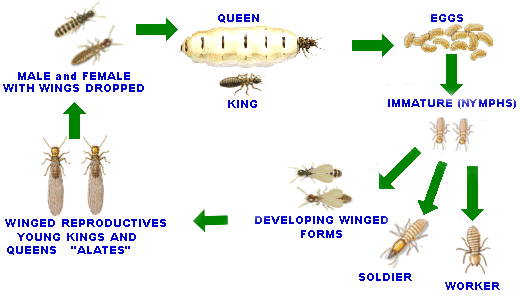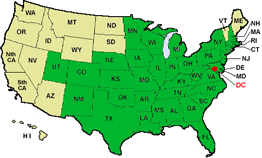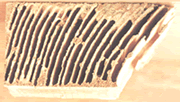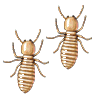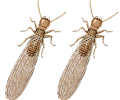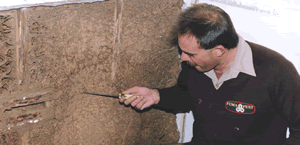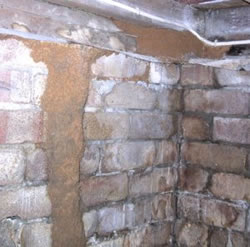|
|
| Destructive Termites in New Hampshire |

| Identification of the main destructive species |
It is critical to identify the species of destructive termites to formulate
an appropriate control program. The main species of destructive
termites in New Hampshire are:
CONTENTS: learn about destructive species of termites - tips on identification
of the timber damage - find out when they swarm in your
local area and how to identify the swarmers, workers and soldiers - learn
about their fascinating biology, life-cycle and behavioural aspects - and receive
professional tips on how best to protect your home from the world's best timber
recycler .... subterranean termites. |
| Eastern
subterranean termites
|
|
Identification of Timber Damage
|
Eastern subterranean termites are highly destructive to douglas fir and
other common building timbers widely used in the construction of homes in
New Hampshire. In large numbers, the subterranean worker termite will rapidly
devour the internal spring wood sections; preferring to leave the harder
summer wood sections.
As a result, infested timbers are often left as a thin external shell, with
layered "honey-comb" hollow sections (as illustrated) packed with moist
soil. Eastern subterranean termites thrive in a moist dark environment.
Moisture and humidity control are essential for their survival. |
|
Destructive nature of Eastern
subterranean termites
|
| The Eastern subterranean termite is a serious economic timber pest causing
millions of dollars of damage throughout New Hampshire. It is estimated that more
than 1 in 5 homes in the urban areas of most New Hampshire cities have been or
will be attacked at sometime by these voracious little insects. |
| The life-cycle
of subterranean termites
|
|
Biology of Eastern subterranean
termites
|
Eastern subterranean termites are a highly social insect centred around a primary breeding nest. The colony consists of several general castes, each with a different role to perform, and interdependent upon each other for their survival... the queen, king, the winged reproductives (young
kings and queens), soldiers and the destructive workers.
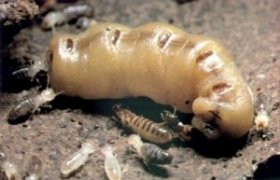
Queen, King and attendant Workers |
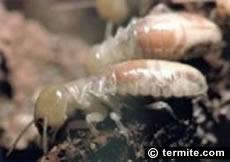
Worker Termites - do all the damage |

|
THE QUEEN TERMITE
is an egg laying machine, her body is enormous compared to her off-spring
and she can live more than 25 years and produce more than 2,000 eggs
a day. |
|
|
THE KING
and queen live in a central chamber and are feed and attended to by
the worker termites. |
WORKER
termites are by far the largest caste in the eastern
subterranean termite colony and
the one that does all the damage. They carry out all work in the nest,
including gathering food (timber and other cellulose), constructing
tunnels, repairing and enlarging the colony nest, grooming and feeding
the soldiers, the king, queen and young nymphs in the nursery.
IDENTIFICATION: Eastern subterranean worker termites are small in
size, about half the size of match-head or 1/8" long. They are a creamy
translucent colour, soft bodied, have no wings, are sterile, blind
and work 24 hours a day for their entire adult life-span. |
SOLDIER termites
are the defenders of the colony, particularly against marauding ants
- with whom they have been at war for more than 250 million years.
IDENTIFICATION: the soldier termite has an orange coloured, rectangular
armoured head, with mandibulate pinchers which they use to crush the
ants. On their forehead is a fontanelle (frontal gland hole) used
to squirt a sticky latex to ensnare the ants. The soldier's mandible
pincers are curved at about 70 to 90 degrees. The body of the Eastern
subterranean termite is flat, with the width of approx 1/32”.
CONSUMER NOTE: If you open termite
infested timbers or their mud tunnels or shelter tubes, it is the
soldier termites that rush out to guard the area whilst the workers
repair the breach. The identification of these insects as "termites"
means an immediate professional inspection and protective measures
are essential to avoid further ongoing or extensive damage. Remember:
the standard home insurance policy in New Hampshire, does NOT cover the
costs of repairs or replacement of termite infested timbers in a home.
|
SWARMERS
or REPRODUCTIVE termites - scientifically called "alates"
are commonly seen by homeowners in New Hampshire, when they swarm in large
numbers, generally in the spring, during daylight. They have eyes,
are poor fliers but can be swept hundreds of yards, by the wind. When
they land, they drop their wings, find a mate to become king and queen
of a new termite colony.
IDENTIFICATION: Eastern subteranean
termite "swarmers" are about 3/8" in length, including wings. They have a
dark brown body and a small fontanelle (frontal opening) on it's
head. Their wings are a brownish grey, with two dark solid veins along
the forefront of the front wings, which are distinctly larger
than hind wings.
WHEN DO THEY SWARM?
In the northern part of their range, swarming takes place in the spring,
but without rain. In the southern areas, swarming usually follows
rain. Occasionally, a few smaller swarms may occur during the summer.
Swarming most often occurs during the morning following a warm rain
shower whereby the soil temperature is around 70°F. The swarmers
are emitted in their thousands when a mature termite nest is large
and well established.
CONSUMER NOTE: If you find swarmer
termites in or around your home, it is a sure sign a large nest is
close by and that your home is at high risk of a termite infestation.
Colony nest development is slow in the first few months, with the
egg-laying capacity of the new queen termite peaking after a few years,
producing up to 10,000 offspring a year. The queen may live for many
years and workers up to two years.
Several years are required
before the termite colony reaches the typically mature size. In some
locations an Eastern subterranean termite colony can contain several
million termites foraging over a wide area (up to 12,000 square feet)
and actively feeding on trees and freestanding poles as well as buildings
and other timber structures.
The colony nests of Eastern
subterranean termites are usually located in the ground below the
frost line, but above the water table. Mud galleries or "shelter
tubes" are constructed across hard objects in order to gain access
to timber food sources.
Eastern subterranean termites
constantly search for new food sources. They are known to enter buildings
through cracks in concrete flooring or to travel under parquetry or
tile flooring through gaps of less than 1/16" wide.
Where moisture regularly
collects inside the wall or other cavities of a building, say from
faulty plumbing or broken roof tiles, the Eastern subterranean termite
can develop a subsidiary colony nest which may not require contact
with the ground to ensure it's survival. |
They build a central colony nest from
which they construct underground tunnels that radiate within a 100 yard
radius from a central colony nest in search of a timber (cellulose) food
source.
The picture on the left shows a termite inspector examining
an above ground termite subsidiary nest built inside a wall
cavity of a home.
Termites often build such nests if moisture is allowed to regularly
collects inside the wall cavity, say from leaking pipes, shower
recess, faulty plumbing, guttering, broken roof tiles, etc.
|
Termites
travel in humidified mud-shelter tubes or galleries...
The picture on the left shows a mud shelter tube that subterranean
termites have constructed over a solid object, in this case,
a brick foundation wall in the sub-floor of a cottage.
Subterranean termites travel in these mud shelter tubes as protection
from predators, sun-burn, dehydration and to maintain a high
humidity environment which is essential for their survival.
Eastern subterranean termites are highly
secretive, preferring to enter a building through areas inaccessible
to inspection, such as, through in-fill patios, fire heaths,
expansion joints and cracks in concrete slab (on-ground) flooring.
Eastern subterranean termites can pass through a 1/8" crack
or an expansion joint (eating through the rubber compound) between
adjoining concrete on ground flooring. They can also travel
under parquetry and floor tiles to get to the wall framing timbers.
|
|
|
|
Eastern subterranean termites
symbiotic digestive system
|
Only the worker termite caste can digest timber by the use of symbiotic
protozoa in their gut. Worker termites feed their partly digested semi-liquid
food, regurgitated from their mouth or passing from their anus, to the other
termites, a process known as trophallaxis.
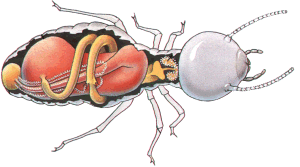
|
Eastern subterranean termites have a well ordered social system with
amazing engineering capabilities and an acute survival instinct; they
obtain moisture from the soil and moist decaying timber, and communicate
using pheromone signals.
The mutual feeding, constant grooming and close
social habits of termites are used to advantage in modern termite
control baiting systems. |
Certain hi-tech termite baits are now on the market that have a delayed
lethal effect on termites which readily pass on the bait to other termites
in the central colony nest during the mutual grooming and feeding.
 |
Eastern subterranean termites need to maintain a high level of humidity
and temperature (75 to 95°F) in their central colony nest.
Eastern subterranean termites eat through the centre of susceptible
timbers leaving nothing but a thin veneer of timber and/or paint.
They will pack mud in cracks and joints in timber to prevent loss
of humidity and resultant dehydration. |
|
As noted above, termites constantly groom and feed each other. A valuable
technique for the termite controller is to instal and monitor a termite
baiting system next to any live activity found in and around the premises
where termite foraging is most likely to occur. Subsequent inspections (preferably
monthly) may reveal dead or sick worker termites, they change colour to
a mottle look, and spread of the termite bait to other termites leading
to elimination of the colony.
The termite baits are designed to be non-repellant to the termites and has
a unique delayed effect. Time enough to be passed onto the other termites
in the colony including the queen, with a sufficient dosage leading to the
elimination of the entire colony. This process is explained in detail in
the Termite Control
section of this website. |
|
If you find these termites do NOT disturb them
|
Eastern subterranean termites have acute survival instincts. If they
are shaken up or disturbed, the termites often will abandon the associated
area and move on to secretly
cause damage in other areas in the building. If you find eastern
subterranean termites in or around your property, it is essential that you
do NOT disturb them and promptly arrange for a professional inspection and
application of a termite bait to the live termites, if present in abundance.
 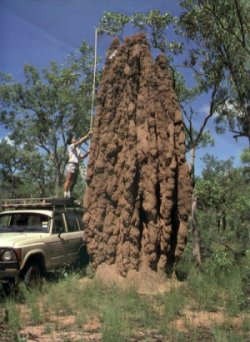 |
Subterranean
Termites...
Mother Nature's most prolific builders
This picture shows a large above ground termite nest found in
the Northern Territory of Australia. In the USA, most of the destructive
subterranean termite species build their nest completely below
ground level. A large Eastern subterranean colony in an urban
environment in New Hampshire is most often unseen, until a serious problem
is encountered.
Modern termite control methods include termite baiting systems;
the installation of a treated soil barrier or eradication zone around
the base of a building; and a range of cultural and home maintenance
measures to make your home less susceptible to subterranean termite
infestation.
Find Out
How to Protect Your Home
Click on ... Termite
Control
|
|
| Published by Fumapest Group © copyright 1995
-
|
|
